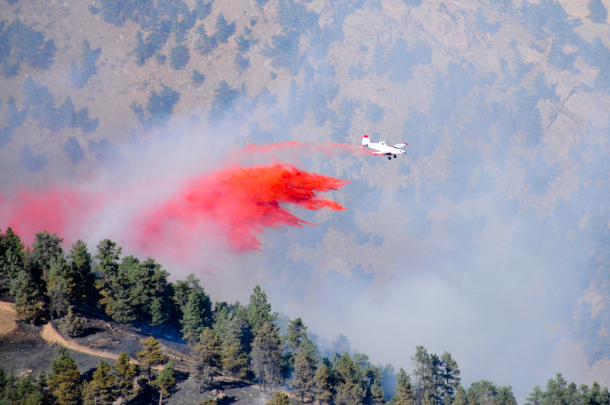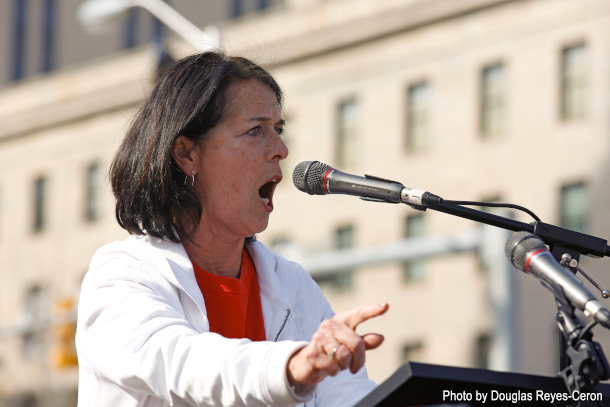Beyond the Headlines
Air Date: Week of April 28, 2023

Aerial fire retardants, which contain ammonium phosphate, are suspected by some as being harmful to waterways and wildlife. (Photo: scatteredVIEW, Flickr, CC BY-NC-ND 2.0)
This week, Living on Earth commentator Peter Dykstra joins Host Steve Curwood to share news of a lawsuit seeking to curb the use of aerial fire retardants to combat wildfires over water pollution concerns. They also shed light on the murder of Ecuadorian Indigenous activist Eduardo Mendúa, who opposed oil drilling in the Amazon. And they look back 70 years to the day Hooker Chemical Company sold off its Love Canal toxic chemical dumpsite for just one dollar, setting the scene for a public health crisis that came to light years later.
Transcript
BELTRAN: It’s Living on Earth, I’m Paloma Beltran.
CURWOOD: And Steve Curwood.
On the line out from Atlanta is Peter Dykstra. Peter's a commentator with Living on Earth and looks beyond the headlines for us from time to time. What do you have for us today, Peter?
DYKSTRA: Oh, hi, Steve. There's a lawsuit in federal court in Montana. The plaintiffs in this legal dispute want to curb the government's use, the US Forest Service, of aerial fire retardant to combat wildfires. The environmentalists who raised the concern are worried about waterways polluted by that sort of red stuff you see in any video footage of planes fighting big wildfires. But that red stuff includes ammonium phosphate, which can be a pollutant in waterways. There may be other toxic chemicals involved. But some of the opponents to stopping the use of aerial fire retardants include the people of a town like Paradise, California, or maybe it's a former town. Back in 2018, Paradise was wiped out and 85 people killed by a wildfire. They don't want to see more homes and more communities and more lives put at risk. But the bottom line here is that the plaintiffs say you'd be stopping one environmental problem by creating a new one.
CURWOOD: Yeah, I mean, this is what climate disruption has given us, right? Neither choice is really a great one. More fires, and therefore the concern and need to suppress them. And yet, we have so many toxic chemicals that we have put together, that we don't have a clean kit of things that we could use in this. Sort of one is the frying pan, the other is the fire, huh?
DYKSTRA: Ugly consequences on both sides.
CURWOOD: Hey, Peter, what else do you have for us this week?
DYKSTRA: Well Steve, you and I have talked over the years about the frequency of environmental activists being murdered in developing countries. Recently, Eduardo Mendúa, who was a leader among Ecuadorian indigenous tribes in opposing oil drilling in the Amazon took 12 bullets to the body. He left behind six children and his wife. And companies have been drilling farther and farther into the Amazon. Some of the indigenous tribes are in favor of that drilling, because it brings money into very poor communities. Others, the communities that Mendúa represented, want to see it stopped, because it's a direct threat to the way of life of these indigenous people in Ecuador.
Eduardo Mendúa, an Indigenous leader representing opposition to oil operations in his community in the Ecuadorian Amazon was murdered in February. Killings of Indigenous peoples defending their territory must end now!https://t.co/3fqFwjGdo4
— Amazon Watch (@amazonwatch) April 19, 2023
CURWOOD: Yeah Peter, this isn't an uncommon scenario. I mean, how many of these assassinations of environmental advocates in other parts of the world that we see each year?
DYKSTRA: Hundreds per year. In the United States, we often talk about harassment of environmentalists. It's legal harassment, or people losing their jobs. Things that are tame compared to rampant murder throughout the world. Per capita a country like Honduras has been a tragic leader in this field. But it tends to be happening more these days, with no end in sight.
CURWOOD: People who want to save the life of the forest, apparently all too often are giving up their own lives for that. Alright, let's take a look back now in the annals of history, Peter. What do you have for us this week?
DYKSTRA: We have a sorry 70th anniversary. On April 28, 1953, the Hooker Chemical company sold its Love Canal chemical dump site to the Niagara Falls Board of Education for $1. What nice guys. The deed included a waiver for any contamination that might be found at the site. Duh, it was a chemical dump site. And then Niagara Falls went ahead and built an elementary school on top of the waste site. They built another one six blocks away, and they built a community all around the Love Canal waste site. There were some serious health problems that came to light years later in the 1970s. The Love Canal tragedy came to national attention led by a housewife activist named Lois Gibbs. The entire area around Love Canal was evacuated by 1980. And it became a synonym, Love Canal, for toxic waste contamination all over America. And it led to the creation of the federal Superfund cleanup program.

Lois Gibbs, an activist mother from Niagara Falls, fought to evacuate families from the Love Canal chemical dumpsite in the 1970s. She is now the Director of the Center for Health, Environment, and Justice. (Photo: chesapeakeclimate, Flickr, CC BY-NC-ND 2.0)
CURWOOD: Right. That program was designed to not let companies who have contaminated something get off the hook just by selling it to somebody else.
DYKSTRA: For a dollar.
CURWOOD: Thanks, Peter. Peter Dykstra is a commentator with Living on Earth, and we'll talk to you again real soon.
DYKSTRA: All right, Steve, thanks a lot. Always good to talk to you.
CURWOOD: And there's more on the stories on the Living on Earth webpage. That's loe.org.
Links
AP News | “Pollution Lawsuit Could Curb The Use Of Aerial Fire Retardant”
Mongabay | “Indigenous Leader Assassinated Amid Conflict Over Oil That Divided Community”
Wikimedia | “Hooker Electrochemical Company sells Love Canal to Niagara Falls Board of Education”
Living on Earth wants to hear from you!
Living on Earth
62 Calef Highway, Suite 212
Lee, NH 03861
Telephone: 617-287-4121
E-mail: comments@loe.org
Newsletter [Click here]
Donate to Living on Earth!
Living on Earth is an independent media program and relies entirely on contributions from listeners and institutions supporting public service. Please donate now to preserve an independent environmental voice.
NewsletterLiving on Earth offers a weekly delivery of the show's rundown to your mailbox. Sign up for our newsletter today!
 Sailors For The Sea: Be the change you want to sea.
Sailors For The Sea: Be the change you want to sea.
 The Grantham Foundation for the Protection of the Environment: Committed to protecting and improving the health of the global environment.
The Grantham Foundation for the Protection of the Environment: Committed to protecting and improving the health of the global environment.
 Contribute to Living on Earth and receive, as our gift to you, an archival print of one of Mark Seth Lender's extraordinary wildlife photographs. Follow the link to see Mark's current collection of photographs.
Contribute to Living on Earth and receive, as our gift to you, an archival print of one of Mark Seth Lender's extraordinary wildlife photographs. Follow the link to see Mark's current collection of photographs.
 Buy a signed copy of Mark Seth Lender's book Smeagull the Seagull & support Living on Earth
Buy a signed copy of Mark Seth Lender's book Smeagull the Seagull & support Living on Earth

